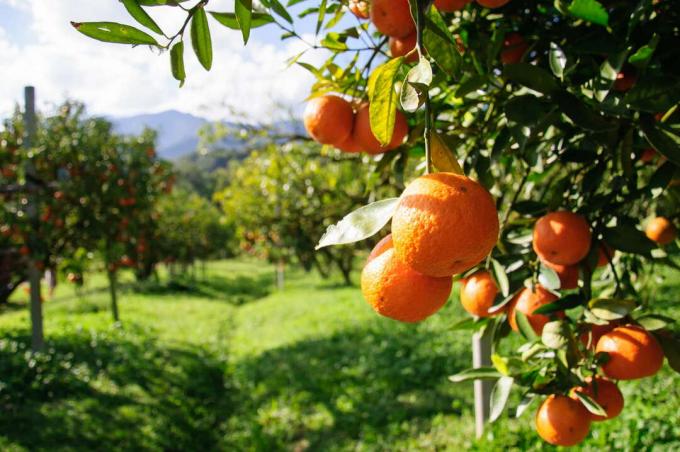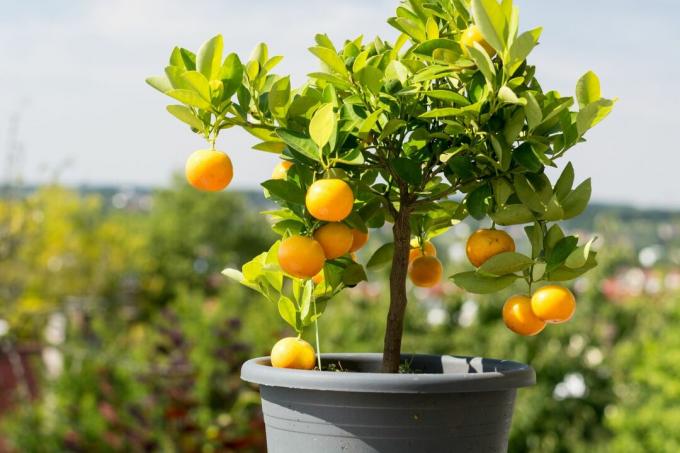An orange tree looks great as a single plant on the terrace and balcony. Here you can find out everything you need to know about the warmth-loving citrus plant.

Orange trees (Citrus × sinensis L.) are popular exotic species, which unfortunately can only be grown in pots in this country due to their sensitivity to frost. With the right overwintering, you can still develop many of the fragrant flowers and, with a lot of luck, even some of the sweet, orange fruits. Grown predominantly in subtropical and tropical countries, oranges are considered to be the most widely grown fruit in the world. In fact, the orange is not a natural species, because the fruit, which comes from Asia, is a cross of mandarins (Citrus reticulata) and grapefruit (Citrus maxima) developed. We show you what to look out for when buying an orange tree and how you can optimally care for the tree.
contents
- Buying an orange tree: what you should pay attention to
-
Plant orange tree
- Suitable location for an orange tree
- Planting an orange tree: instructions
-
Caring for the orange tree properly
- Orange tree: how often and how much water?
- Orange tree: when and what to fertilize with?
- Pruning orange trees: when and how?
- Successfully overwintering the orange tree
Buying an orange tree: what you should pay attention to
You can easily buy orange trees in any garden center or nursery, but the following factors are decisive in the selection:
- Size of the plant
- variety
- health status

In principle, smaller specimens can be purchased without any problems, as orange trees grow very quickly. When choosing a variety, you should definitely pay attention to whether you want a sweet orange variety or if you prefer a bitter orange. Bitter oranges are rather unsuitable for consumption, but beguile with their strong floral scent. An essential criterion when buying an orange tree is the health of the plant, which you should always check before buying. Check the plant for pests and diseased plant parts to ensure a long lifespan. In the case of oranges, it is always advisable to choose a refined specimen, as this increases the resistance.
Plant orange tree
Proper repotting of the exotic plant is important for the lush growth of orange trees so that the roots can spread and new substrate can be supplied. But how do you actually plant an orange tree correctly and which location is suitable?
Suitable location for an orange tree
As a heat-loving plant, the citrus plant needs special conditions for optimal growth. Specimens that are on the balcony or terrace should always be placed in full sun on the wall of the house in summer. South and westerly locations are therefore particularly suitable due to the higher solar intensity. When growing indoors, you should always ensure a bright spot by the window. It is advisable to allow enough space for orange trees that are both indoors and outdoors. The Mediterranean plants can grow rapidly with the right temperatures and enough sun.

These tips should be heeded when choosing the right location:
- Full sun location
- For culture outside: south or west side of the house
- In the case of culture in the house: a bright space at the window
- Enough room to grow
Planting an orange tree: instructions
When planting orange trees, there are a few things to consider so that the plant can grow well and develop flowers and fruits. The most important points are summarized below:
-
The right time
Repot your orange tree in February. Now the growing season starts and the roots begin to grow vigorously again. By repotting before the growing season, the roots can root through the new substrate faster. -
Choose a bucket that is large enough
Too small a tub often limits the growth of orange trees, so choose a suitable tub when repotting. This should usually be a third larger than the root ball so that new roots can develop. Young orange trees are ideally repotted every year, older ones every few years. -
Choosing the right soil for the orange tree
For the cultivation of citrus plants such as oranges and lemons, there are special citrus soil available in stores that have all the appropriate properties for growing in pots. If you choose a different soil or mix them together yourself, the substrate should in any case be permeable and not loamy. -
Plant the orange tree at a suitable height
When planting the tree in the new pot, care should be taken to lay a thin layer of drainage at the bottom of the pot. This can consist of expanded clay or gravel, for example, and drains away excess water. Fill a few inches of soil over the drainage layer before planting the orange tree. After insertion, the cavities should be filled with substrate. -
Water the orange tree well after planting
In the last step, you should water the newly planted tree vigorously in order to provide enough water directly. Nevertheless, be careful not to soak the soil completely with water.
Caring for the orange tree properly
Like many other citrus plants, oranges require a certain amount of care, especially during the summer growing season. We show what needs to be considered.
Orange tree: how often and how much water?
During the summer, orange trees require a large amount of water, especially when producing fruit. You should therefore water your tree daily and avoid the soil drying out completely. Low-lime water such as rainwater is best suited for this. You can then reduce the watering considerably during the winter.
Orange tree: when and what to fertilize with?
Spring is a suitable time for the first fertilization of the year, when the growth phase begins. Basically, fertilization is only applied over the growing season in summer; you should stop fertilizing in autumn. The use of commercially available citrus fertilizers, which can be added to the irrigation water, is an effective fertilizer. As a more ecological alternative to normal fertilizers, it is worth using organic citrus plant fertilizers or using a long-term fertilizer such as our Plantura Organic tomato fertilizer.
Pruning orange trees: when and how?
Depending on what you're planning to do, the timing and cutting technique will differ. For the purpose of a shape cut and to clear out inwardly growing and dead shoots, a cut in autumn is always a good idea. Ideally, make the cut shortly before the winter dormancy period. Stronger pruning measures such as rejuvenation should be carried out in spring.

When pruning orange trees, note the following times:
- Form and clearing: end of the growing season (autumn)
- Rejuvenation cut: spring
With light pruning work in autumn, you can thin out the crown of the orange tree by removing dense shoots. So that the wintering tree does not take up too much space, it is also worth slightly pruning protruding shoots. A rejuvenation cut is advisable when the tree is becoming increasingly bare and hardly leaves any more leaves. Cut the plant back to a few stumps so that it can sprout again over the summer.
More tips for the perfect Pruning orange trees You will find here.
Successfully overwintering the orange tree
An essential aspect when dealing with orange trees is the annual overwintering, as the subtropical plant is not hardy. A temperature of around 10 ° C has proven to be ideal for wintering, temperatures above 15 ° C should be avoided at all costs. Temperatures that are too high require a lot of light from the tree, which unfortunately is not enough in the German winter. So choose a bright but cool place for your orange tree.

A cool place should be selected for the wintering of the orange tree, but it should always remain frost-free. Temperatures of under 5 ° C can already affect your Mediterranean tree and should always be avoided.
At what temperature does it become critical for the orange tree?
- Ideal temperature at 10 ° C
- Not below 5 ° C or above 15 ° C
- Cool and bright place
More information on the correct Wintering your orange tree can be found in our special article.

